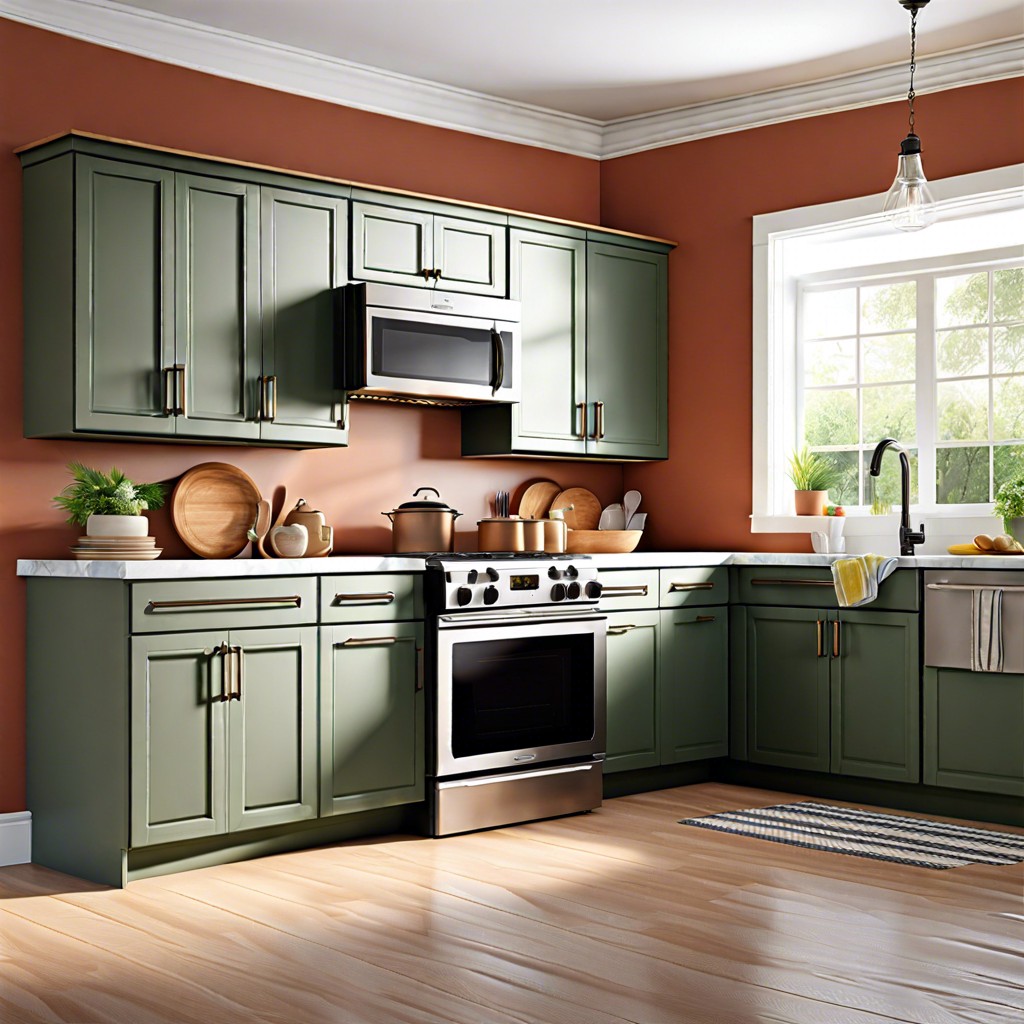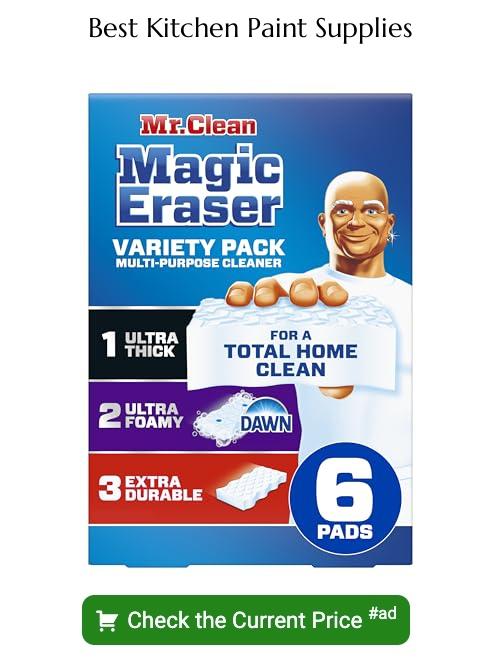Last updated on
Learn how much it costs to paint a kitchen and which factors influence the total price.
Key takeaways:
- The average cost to paint a kitchen ranges from 0 to ,000.
- Factors influencing the cost include the size of the kitchen, type of paint chosen, and any necessary prep work.
- Materials needed for kitchen painting include paint, primer, brushes, rollers, tape, and drop cloths.
- Labor costs for hiring professionals vary based on experience, expertise, prep work, complexity, and geography.
- Different surfaces in the kitchen, such as walls, ceilings, cabinets, trim, and behind appliances, have different cost implications.
- The cost to paint a kitchen increases with the size of the kitchen.
- DIY can save money, but hiring a pro ensures a flawless finish.
What's Inside
Average Cost to Paint a Kitchen

Now, let’s get to the fun part—numbers! The average cost to paint a kitchen can range anywhere from $300 to $1,000. The price largely depends on several factors:
First, the size of your kitchen. If you have a tiny, cozy galley kitchen, you’re in luck—less wall space means less paint and less money! But if your kitchen could double as a small gymnasium, prepare to shell out a bit more.
Second, the type of paint you choose. Standard latex paints will be lighter on your wallet compared to high-end designer paints or specialty finishes like chalkboard or magnetic paint. Yes, you can turn your kitchen into a giant post-it!
Third, any prep work required. If your walls look like they survived a toddler art attack, you’ll need to factor in costs for patching and priming. Smooth surfaces save time and money.
Remember, this is a ballpark figure. Actual costs can vary, and it’s always a good idea to get a couple of quotes if you’re hiring a pro. Just don’t forget to budget for pizza delivery—you’ll probably be without a functioning kitchen for a bit!
Kitchen Painting Materials Prices
To transform your kitchen with a fresh coat of paint, you’ll need the right materials. Let’s break down the essentials:
First up, the paint. Depending on your chosen brand and finish (matte, eggshell, satin, semi-gloss), it can range from $15 to $60 per gallon. Keep in mind that kitchen walls usually require more durable finishes to withstand all that cooking chaos.
Next, primer. Essential for prepping those walls, especially if you’re covering dark colors or stains. Expect to spend around $20 to $30 per gallon.
Don’t forget brushes and rollers. Quality tools make a big difference. A good brush can cost $10 to $20, and rollers usually run $5 to $15 each. Toss in some painter’s tape and drop cloths, and you’ve added another $15 to $25 to your cart.
Lastly, factor in a few extras. Sandpaper, cleaning supplies, and paint trays might seem minor but can collectively add around $10 to $20.
Did you think painting would be so accessorized? Just like your favorite outfit, but for walls!
Kitchen Painting Labor Costs
Hiring professionals for the job means factoring in labor costs. These costs can vary, but here’s a rundown to give you a clear picture:
Experience matters. Seasoned painters may charge more, but they bring efficiency and expertise to the table. Think of it like hiring a chef versus a kid who barely knows how to boil water.
Area of expertise. Some painters specialize in kitchens and understand the intricacies, such as maneuvering around cabinets and appliances, which can impact costs.
Prep work. If your kitchen walls need sanding or repairing, expect additional costs. It’s like when you try cooking a fancy meal but first need to clean the kitchen from last night’s spaghetti disaster.
Complexity. Intricate trim details or elaborate color schemes can also hike up the price. It’s like asking your barista for a triple-shot, half-skinny, half-almond milk latte with caramel drizzle – you’re going to pay more for the complexity.
Geography. Where you live plays a role. In major cities, labor rates tend to be higher compared to smaller towns. Just like how a coffee in New York costs more than in a small town diner.
Having a clear understanding of these factors helps in budgeting and making an informed decision. Now, let’s dive into different cost aspects to get a holistic view.
Kitchen Painting Cost By Type
When considering the various surfaces in a kitchen, each type can impact the painting cost. Let’s break this down.
Walls: Painting walls is typically the least expensive. There’s a straightforward surface with minimal prep compared to, say, cabinets.
Ceilings: Depending on the kitchen’s height and complexity, ceiling repainting can add to the cost. Think about those fancy crown moldings—they’re beautiful but can be a bit of a budget buster.
Cabinets: Oh, the beloved cabinets. Painting them can be very labor-intensive and thus more expensive. We’re talking about removing hardware, sanding, priming, and multiple coats of paint. Your kitchen might be out of commission for a bit too.
Trim and Baseboards: These areas can often be overlooked, but they need love, too. Painters have to be meticulous here, so it can cost a bit more, especially if there are lots of nooks and crannies.
Behind Appliances: This is the hidden territory. Moving appliances to paint behind them can add some extra time and cost, particularly if you’ve got one of those massive fridges that seem like they’re welded to the floor.
Different surfaces, different challenges, different cost implications. Choose wisely, and your kitchen will thank you.
Cost to Paint a Kitchen By Size
Small kitchens (70-100 sq. ft.) usually cost less to paint, often between $300 and $700.
For medium kitchens (100-200 sq. ft.), expect costs around $600 to $1,200.
Large kitchens (200+ sq. ft.) can hit $1,000 to $2,000 or more.
Size matters because more square footage means more paint and more labor. Bigger kitchens might need extra ladders, scaffolding, and, let’s be honest, more snacks for the painters. If you have a large open-space kitchen, those walls morph into mini skyscrapers.
Remember, intricacies count too. Extra cabinetry and trim make even a smaller kitchen act like a bigger one. The devil’s in the details, and also in the wallet.
DIY Vs. Hire a Pro
Opting for DIY can save you a chunk of change. You’ll mainly spend on paint, brushes, and a few other supplies. Plus, there’s the satisfaction of looking around your newly painted kitchen and saying, “I did that!”
However, hiring a pro means ensuring a flawless finish. Professionals bring experience, precision, and all those fancy tools you didn’t even know existed. If you’re short on time or not exactly a Picasso with a paintbrush, consider leaving it to the experts.
Still torn? Ask yourself: Do you have the time? How about the patience? And do you relish the idea of a paint-splattered weekend? If yes, DIY might be your calling. If not, your pro painter awaits.





